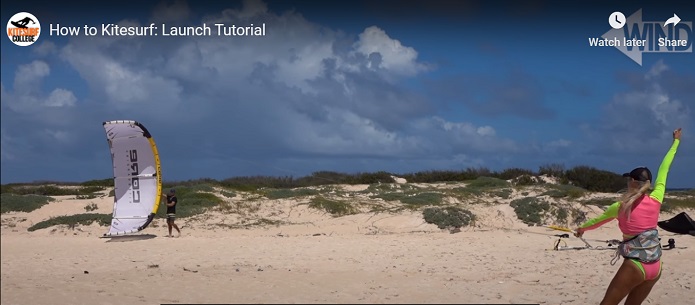Hopefully you’ve read my article “How to Set Up a Kitesurfing Kite”. And have your kite all set up on the beach, checked and with the lines downwind of the kite. So in this article we’re going to look at how to launch a kite safely.
This is the point where most kitesurfing accidents happen (speaking from painful experience) so it’s not worth cutting corners. But by taking the right precautions your session will start on a happy note.
My articles on technique are not designed to replace lessons from a qualified instructor. But there’s a lot going on in your lessons and it’s very easy to forget what you’ve learned. So it’s good to use them as revision to prepare yourself before you go out alone.
If you’re anywhere near the North of the United Kingdom, why not check out Northern Kites where you’ll find me teaching alongside the rest of the team whenever the wind is right.
As a beginner you shouldn’t try to self launch your kite as if anything goes wong at this stage you could cause serious injury to yourself or other beach users.
And never ask a non-kiter to launch for you as the person launching needs to know what they’re doing just as much as you do.
Video Courtesy of Alex at Kitesurf College
Safety Check
You’ve already checked your lines and kite are set up correctly and there’s no wear or damage. So now it’s time to check the launch area.
You’ll be picking up the bar and walking with the lines kept reasonably taught towards the wind in an arc. So make sure there are no obstacles, such as rocks, boards, people, bags in the way.
On busy beaches you’ll often find that someone has set up their kite between you and the water by the time you’ve rigged up. It’s not ideal but just be careful to lift your lines high enough to clear any obstacles safely.
But better still, try to spot a clear area nearby. Then ask your assistant to pick up the kite and, with you holding the bar with the lines reasonably tight, both walk towards that area.
Getting Into Position
Firstly, place your board safely away from where you’re going to be moving the lines. It’s quite common to see a board get snagged in the lines leading to all kinds of trouble. I like to put it between where I’ll be standing to launch and the water.
Before your assistant picks up the kite you now need to attach your safety leash to the correct attachment on the lines. Next connect the chicken loop to your hook and make sure the “chicken stick” or “donkey dick” is inserted through the hook and is secure.
The reason you do it this way round is that, by attaching the leash first and the chicken loop second, you ensure that you aren’t attached to a non-secured kite. So if you suddenly need to release the chicken loop by firing the primary safety, the kite isn’t going to blow away downwind with the lines dragging behind.
With leash and chicken loop secured walk backwards enough to put tension in the front lines. Don’t hold the bar at this point, just let it hang in front of you.
At this point check again that the lines are all separate and no bits of twig or shells have attached themselves to the line.
If there’s anything wrong at this point, give your assistant the thumbs down signal and wait until they’ve put the kite down. Then detach yourself and sort out the problem.
Assuming everything’s good with the lines, start walking in an arc towards the wind, still keeping the front lines under tension but with your hands off the bar.
You can go in either direction, left or right, to go upwind. I always prefer to launch the kite with the kite towards the shoreline and me inland.
That way, if you suddenly get powered up you’ll be dragged into the water rather than towards any obstacles inland.
But It’s not always possible because of space or wind direction. But if you have the option it’s best.
By keeping tension in the front lines you can walk with the lines off the beach so they don’t get snagged. It also means you’ll be able to tell as you get into the right position as you’ll feel the kite start to pull slightly.
The ideal launching position is with the lines almost at a right angle to the wind direction, with the kite very slightly downwind of you.
The sign that you’re in the right position is when the kite, which your assistant is holding with one tip down and one up, starts to fill with wind and stops flapping.
If you get too far upwind of the kite it should start to push forward towards your assistant. When that happens you need to take a few steps back downwind until the kite rests in your assistant’s hands, supported by the wind but not trying to push backwards or forwards.
It’s crucial to get this bit right. If the kite is too far downwind of you it will launch very quickly in a powered-up state and could either drag you down the beach or shoot up into the sky and “loft” you into the air.
If it’s too far upwind, as soon as your assistant lets go it will start to drift away from them downwind. This could firstly injure someone else on the beach or secondly the kite could suddenly power up with a jolt.
In the ideal position you can slowly steer the kite straight up towards 12 o’clock.
The Launch
Okay, good to go!
By this stage the bar should be the right way around so the red or brightly coloured side is near your left hand.
At every stage of the launch you should have your hands away from the bar. You’re going to steer the kite by gently holding the uppermost float on the leader line. The other hand should be ready to pull the primary chicken loop release in case a sudden gust catches the kite and launches it downwind or up into the air.
At this point you shouldn’t have your hands on the bar. The safest way to launch is by holding the uppermost float, which is the foam part where the steering line attaches to the bar.
Move backwards to put a bit of tension on the power lines, which are attached to the chicken loop. You’ll now get a feel for how much power is in the kite. If it’s starting to pull you, then it might be overpowered. So if it is then pull a bit of de-power on. If it’s still pulling with the de-power line fully pulled down then you might have the wrong sized kite.
Don’t be tempted to launch an over-powered kite! Seriously, this is the most common cause of kitesurfing accidents. I’ve got the scars to prove it!
Now before you launch have a final check around you to make sure there are no kiters in close proximity with their kite in the air.
When you’re ready, give your assistant the thumbs up sign. As they let go just steer the kite gently up towards the 12 o’clock position using a light grip on the float. Only move your hand gently to the bar once the kite is up near the 12 o’clock position.
Now check your trim again. Once you’re in the water the kite should feel comfortable with the bar in the midway position. However, if you’ve got a bit of distance to walk to the water it’s best to have the kite trimmed so that it’s staying in the air but not trying to pull you down the beach when the bar’s in the midway position.
This reduces the risk of a sudden gust launching you down the beach or into the air.
Getting to the Water
As a beginner you should ideally not be launching in a crowded area of the beach. But if it is busy you need to be constantly aware of other kiters.
Look out particularly for anyone coming out of the water. The rule is that the kiter coming out of the water should steer their kite towards the water and the one on the beach should lower it towards the land side. But this isn’t always possible, so if in doubt keep your kite up towards 12 o’clock and wait for anyone else to get clear of you.
As you walk towards the water the ideal position for the kite is somewhere around 10 or 2 o’clock. Having the kite at 12 o’clock feels more comfortable but risks you getting lofted if it’s gusty.
That said, you will see experienced kiters walking around with their kite at 12 o’clock. But ideally have it a bit lower.
Ready to Go!
Now you just need to choose the right bit of shore to launch from. Ideally not too much shore-break and fairly quiet.
The next stage, the water-start is covered in another article.
I hope you’ve found this helpful and if you hit the “like” button you’ll get updates on new articles as I publish them – no spam!
I love to get feedback so if you have any comments or questions do leave them in the box below.


